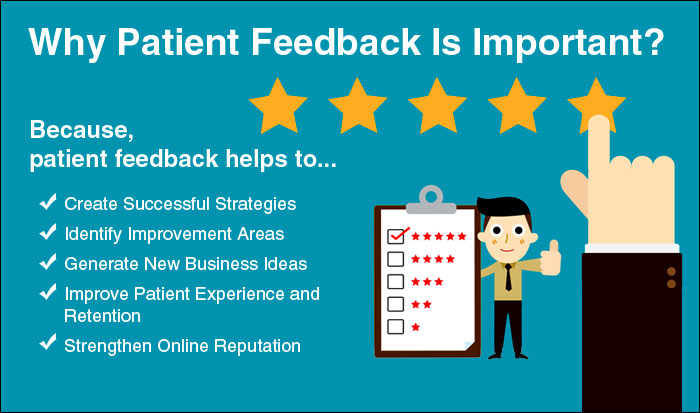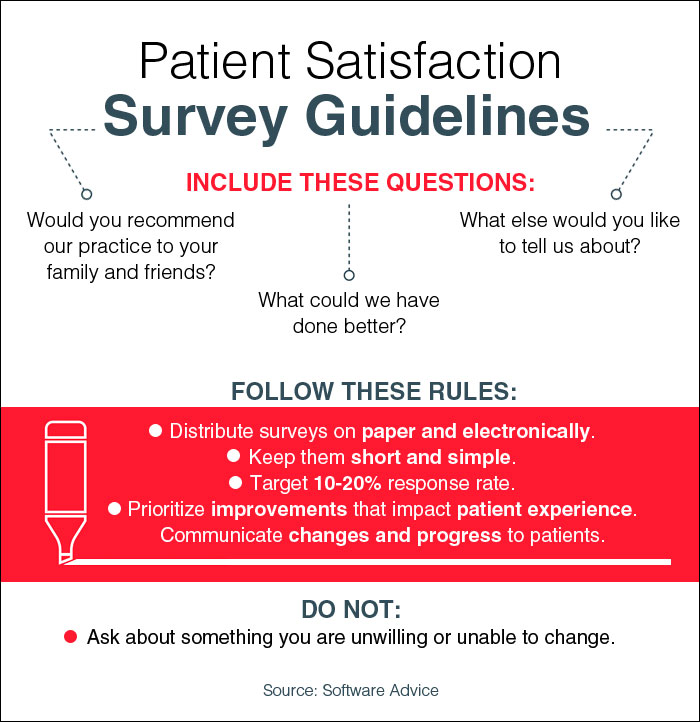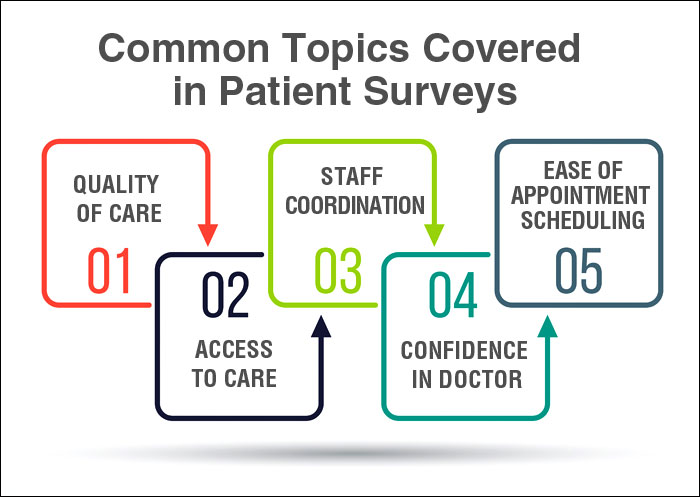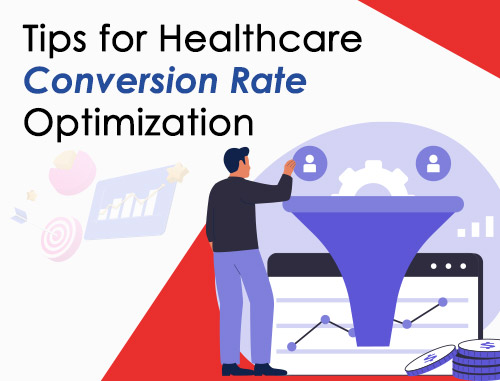Patient Feedback Survey: How Asking the Right Questions Can Help Your Practice
Posted on
A nicely crafted patient satisfaction survey is one of the best methods practices have for understanding their strengths and knowing what they should improve.
Surveys are an excellent way to assess patient satisfaction, brand potential, service quality, price comparison and much more. However, there are right and a wrong ways to frame survey questions. The way you write your survey questions has a direct impact on the response rate as well as the efficacy of the responses.
Getting Started With Surveys
Simply put, patient surveys help you find answers to different business questions. Of course, the better-quality questions you ask, the better responses you will get. And, in the context of conversion optimization, asking inappropriate questions can lead you down the wrong path.
Therefore, for your patient experience and conversion research efforts, it is important to spend a little more time on creating meaningful questions.
As David F. Harris suggested, “If we make survey questions clear, answerable and unbiased, we can reduce the survey length, enhance respondents’ experience and significantly improve the quality of data.”
The right questions are not just about getting you better responses for better decisions. The surveys and the responses can affect your practice’s reputation. Your survey length and questions will either enhance your brand or turn respondents away.
Most practices use online survey tools rather than someone calling patients to ask questions. Online surveys are less pushy than personal calls or questions, and they are easy to put together. Online tools such as SurveyMonkey can help you get an online survey up and running in a matter of minutes.
Even though you can publish your patient satisfaction survey quickly, it is always better to take your time and create effective and thoughtful questions that will generate valuable responses to your medical practice. The right questions can make a big impact on your practice.

Types of Survey Questions
One of the most powerful factors in designing a successful survey is the quality and relevance of your questions. At the end of the day, well-drafted questions are key to every successful survey, whereas poorly structured questions can result in incorrect responses, which are, ultimately, a waste of time.

Thoughtfully crafted questions driven by a strong collection mechanism are imperative in ensuring valuable data. Yet, the importance of using the right question types is often ignored. It is essential to align your question types with the overall framework of your survey.
Make sure you define your survey’s goals, sample size, target audience and survey method before creating the questions. Paying attention to these details can transform the way your target audience will interact with the survey. In addition, you can expect rich dividends in gathering useful data that justifies the purpose of the campaign.
The types of questions you include in your survey can have a powerful influence on the input you are able to gather, and they could be the difference between a survey that helps you make an informed decision and the one that leaves you with more confusion.
Essentially, there are two types of questions you can ask in a survey: open-ended and closed-ended questions.
Open-ended questions require your target audience to answer the questions in their own words. For instance, you might ask, “What did you like the most about your visit today?” Or, “You have used some of our additional services in the past, so why are you no longer using them?”
Open-ended questions can provide you with the most detailed feedback from your patients. You must allow the respondents to give you an honest opinion about your services in their own words. This type of questions will generate useful feedback. However, try not to overuse them. One open-ended question per survey should be sufficient.

Open-ended questions give your patients the opportunity to:
- Use their own words to respond to your questions.
- Show the depth and strength of their thoughts.
- Narrate their experiences as much as they want.
- Give exact representations of personal views.
However, there are some challenges to open-ended questions:
- Answers may vary in length and quality.
- Uninterested patients may not take the time to give you detailed feedback.
- Assessing data can be a tedious and time-consuming process. In addition, you may risk losing some of the rich details that comments can provide.
To sum it up: You may consider using open-ended questions when you are looking for detailed feedback. Open-ended questions may result in some great follow-up questions for gaining additional insights.
Closed-ended questions require your patients to choose from a list of responses that you provide.
For instance, a small practice curious about patient satisfaction may ask, “How satisfied are you with our services?” and provide four response options: Very Satisfied, Satisfied, Dissatisfied and Very Dissatisfied.
Closed-ended questions give your patients the opportunity to:
- Quickly answer the questions since response options are available.
- Responses are easier to compare and analyze.
In addition, closed-ended questions are faster to summarize. You can easily assess what percentage of your patients selected each answer choice, or you can make a comparison between how two groups of patients answered a question.
Here are some of the limitations of closed-ended questions:

- Uninterested patients may select a random response option, thus decreasing the survey’s credibility.
- Patients may feel frustrated due to the limited choice of response options.
To sum it up: You may consider using closed-ended questions when you have a good understanding of patient behavior and can come up with the correct set of response options for the questions. In some cases, including an “Other” category will help reduce any frustrations your patients feel when they are asked to select from a limited number of response options.
Deciding when to use an open-ended or a closed-ended question is an integral part of survey design. If you look at the opportunities and challenges of each question type, you will be on your way to collecting relevant data that your practice can use to drive decision-making.

Useful Tips
If done well, a patient satisfaction survey that follows best practices can provide eye-opening information – the kind that changes the direction of a medical practice for the better. On the other hand, a poorly drafted survey will yield inadequate data while making the respondent frustrated.
So why do these directionless, agonizing patient surveys persist?
Too often, healthcare marketers fall into the trap of focusing exclusively on their own desire for information, and not on the experience that they create for patients. When this occurs, respondents take a shortcut through the survey, and neither party wins.
In order to correct such errors, we have put together four helpful tips that can push your respondents through the whole survey in a way that creates a positive experience, without compromising on the actionable information.
1. Keep it Simple and Concise:
Regardless of your target audience, use simple and straightforward language and tone in all of your questions. Most respondents will not take the time to read a question more than once.

When it comes to patient satisfaction surveys, simplicity is key. This is because you are trying to reach out to people who probably are busy. So it is best to make your questions easy for them to understand and then answer them as quickly as possible. Asking complex questions may confuse respondents. When this happens, two things are bound to follow: Either the respondents will reject your survey or they will give you hasty and incorrect responses.
Brevity is also important. A lengthy survey may cause an incredibly high rejection rate. You want respondents to honestly respond to your questions, and a 50-minute survey cannot support that.
2. Speak Your Target Audience’s Language
When creating a survey, there is often a temptation among healthcare marketers to make the phrasing of questions as bland as possible. This is because a lot of marketers fear that inserting unnecessary content may dilute the results of the survey. This is a valid concern. After all, surveys are not supposed to entertain; they are supposed to extract meaningful information. However, surveys should not be boring. In fact, surveys should engage the participants enough to inspire creative and constructive feedback that can be used to grow and market your practice. Though it is obvious, the best way to write an easy survey is to speak the language of your respondents. This means minimizing the use of words or phrases that may confuse your target users.
3. Limit the Number of Response Options
When you ask your survey participants to rank your services in order of preference or importance, try not to give too many options. While it is difficult to fix the exact number of response options that you can provide, a good tip is to offer a complete list of the most likely choices and then provide an “other” option to collect input from the rest of the responses. Asking your respondents to rate or rank a long list can result in a rejected survey. If you need to get respondents’ feedback on all of the items on your list, consider splitting the original question into two separate questions.
4. Include Open-Ended Questions
Open-ended questions are viewed as risky as they are difficult to quantify. However, open-ended questions can be of great use, and it is important to include at least one or two such questions in your survey. Patients often have a lot on their mind, and allowing them to answer a question in detail can provide you with extensive feedback that you may not have received otherwise.
When asking open-ended questions, you must be careful as some respondents may provide you with long, unnecessary responses. In order to prevent such incidents, provide a text box where target users can write their answers and limit the number of characters the text box can accept.

Conclusion
Once you have finalized the questions you want to ask, think about the best time to ask these questions of your target audience. If you are asking for feedback on a recent event, for instance, you may have to follow up quickly while the event is still fresh in your target audience’s minds. However, if your survey is not time-sensitive, you can consider sending single-question polls on a regular basis.
An awesome patient experience and excellent service begin with getting to know who your target audience are and what they want from your practice. In order to get that done, you have to gather patient information, and surveys are just a means to achieve that. When reaching out to collect patient information, it is important to get it right from the beginning. The number and types of questions you ask will play an integral role in determining the success of your survey.
There are right questions, and there are wrong questions. Your goal should be to ask the right questions because the wrong questions can get you completely unfitting responses.
If you take the time to write appropriate questions, you will be on your way to getting valuable patient information that can help you drive your practice in the right direction.

 How to Create a Winning Healthcare Marketing Strat..
How to Create a Winning Healthcare Marketing Strat.. Tips for Healthcare Conversion Rate Optimization
Tips for Healthcare Conversion Rate Optimization What Marketers Don’t Know About Effective Audien..
What Marketers Don’t Know About Effective Audien..